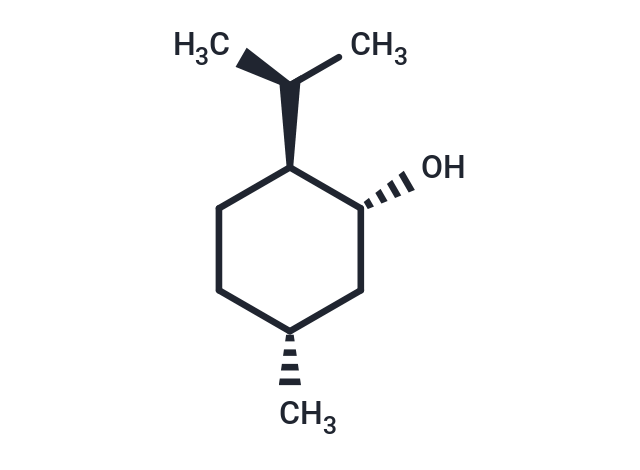Shopping Cart
Remove All Your shopping cart is currently empty
Your shopping cart is currently empty
(-)-Menthol (Levomenthol) is a levo isomer of menthol, an organic compound made synthetically or obtained from peppermint or mint oils with flavoring and local anesthetic properties. When added to pharmaceuticals and foods, menthol functions as a fortifier for peppermint flavors. It also has a counterirritant effect on skin and mucous membranes, thereby producing a local analgesic or anesthetic effect.

| Pack Size | Price | USA Warehouse | Global Warehouse | Quantity |
|---|---|---|---|---|
| 2 g | $31 | - | In Stock | |
| 5 g | $48 | - | In Stock | |
| 1 mL x 10 mM (in DMSO) | $29 | In Stock | In Stock |
| Description | (-)-Menthol (Levomenthol) is a levo isomer of menthol, an organic compound made synthetically or obtained from peppermint or mint oils with flavoring and local anesthetic properties. When added to pharmaceuticals and foods, menthol functions as a fortifier for peppermint flavors. It also has a counterirritant effect on skin and mucous membranes, thereby producing a local analgesic or anesthetic effect. |
| In vitro | (-)-Menthol induces cytotoxicity against murine leukemia WEHI-3 cells in vitro in a dosedependent manner. (-)-Menthol inhibits the growth of rat liver epithelial tumor cells and acts as a potent chemopreventive agent during DMBA initiation of rat mammary tumors. (-)-menthol inhibits N-acetyltransferase activity. It also is found to inhibit the DNA topoisomerase I, II alpha and beta and to promote NF-kappaB expression in human gastric cancer SNU-5 cells. Additionally, (-)-menthol induces human promyelocytic leukemia HL-60 cell death through the Ca2+ release from the endoplasmic reticulum[1]. |
| In vivo | The effects of (-)-menthol on WEHI-3 cells in vivo (BALB/c mice) were also examined, and it was observed that the Mac-3 and CD11b markers were decreased, indicating inhibition of differentiation of the precursor of macrophage and granulocyte. The weights of liver and spleen samples from mice treated with (-)-menthol were found to be decreased compared to untreated animals. (-)-Menthol has been shown to be toxic in animals, but in humans, it is considered to be safe, with a small cardio-accelerating effect. At high doses (-)-menthol may exert a depressant effect on the central nervous system in rodents. (-)-menthol statistically decreases the weights of the liver and spleen in the examined animals and also decreases the percentage of MAC-3 and CD11b cells in the blood.[1]. |
| Cell Research | Approximately 2x105 cells (WEHI-3) are incubated in 12-well plates containing medium for 24 h without (control) or with various concentrations (0, 25, 50, 75 and 100 μM) of (-)-menthol. The cells are harvested and washed with PBS before PI staining. The percentage of viable WEHI-3 cells is determined by trypan blue exclusion and flow cytometry. (Only for Reference) |
| Synonyms | Menthomenthol, Menthacamphor, L-Menthol, Levomenthol |
| Molecular Weight | 156.27 |
| Formula | C10H20O |
| Cas No. | 2216-51-5 |
| Smiles | [C@H](C)(C)[C@H]1[C@H](O)C[C@H](C)CC1 |
| Relative Density. | 0.49 g/cm3. Temperature:20 °C. |
| Storage | Powder: -20°C for 3 years | In solvent: -80°C for 1 year | Shipping with blue ice/Shipping at ambient temperature. | ||||||||||||||||||||||||||||||||||||||||
| Solubility Information | H2O: 13 mg/mL (83.19 mM), Sonication is recommended. DMSO: 50 mg/mL (319.96 mM), Sonication is recommended. Ethanol: 29 mg/mL (185.58 mM), Sonication is recommended. | ||||||||||||||||||||||||||||||||||||||||
| In Vivo Formulation | 10% DMSO+40% PEG300+5% Tween 80+45% Saline: 2 mg/mL (12.8 mM), Sonication is recommended. Please add the solvents sequentially, clarifying the solution as much as possible before adding the next one. Dissolve by heating and/or sonication if necessary. Working solution is recommended to be prepared and used immediately. The formulation provided above is for reference purposes only. In vivo formulations may vary and should be modified based on specific experimental conditions. | ||||||||||||||||||||||||||||||||||||||||
Solution Preparation Table | |||||||||||||||||||||||||||||||||||||||||
H2O/Ethanol/DMSO
Ethanol/DMSO
| |||||||||||||||||||||||||||||||||||||||||
| Size | Quantity | Unit Price | Amount | Operation |
|---|

Copyright © 2015-2026 TargetMol Chemicals Inc. All Rights Reserved.